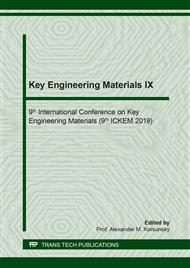[1]
Chao Zheng, Yonghong Liu, Jie Qin, Cheng Chen, Renjie Ji, Wear behavior of HVOF sprayed WC coating under water-in-oil fracturing fluid condition,, Tribology International, 115, pp.28-34, (2017).
DOI: 10.1016/j.triboint.2017.05.002
Google Scholar
[2]
Sebastian Goeke, Tobias Brüggemann, and Dirk Biermann, Development of Machining Processes for the Use of Multilayer High-Performance Coatings,, ISRN Tribology, vol. 2013, 6 pages, (2013).
DOI: 10.5402/2013/750251
Google Scholar
[3]
J. Rodrıguez, A. Martın, R. Fernández, J.E. Fernández, An experimental study of the wear performance of NiCrBSi thermal spray coatings,, Wear, 255, pp.950-955, (2003).
DOI: 10.1016/s0043-1648(03)00162-5
Google Scholar
[4]
G. Bolelli, L.-M. Berger, T. Börner, H. Koivuluoto, L. Lusvarghi, C. Lyphout, N.Markocsan, V. Matikainen, P. Nylén, P. Sassatelli, R. Trache, P. Vuoristo, Tribology of HVOF- and HVAF-sprayed WC-10Co4Cr hardmetal coatings: A comparative assessment,, Surface and Coatings Technology, 265, pp.125-144, (2015).
DOI: 10.1016/j.surfcoat.2015.01.048
Google Scholar
[5]
S. Sampath, X.Y. Jiang, J. Matejicek, L. Prchlik, A. Kulkarni, A. Vaidya, Role of thermal spray processing method on the microstructure,, Materials Science and Engineering A, 364, pp.216-231, (2004).
DOI: 10.1016/j.msea.2003.08.023
Google Scholar
[6]
Davide Fantozzi, Ville Matikainen, Mikko Uusitalo, Heli Koivuluoto, Petri Vuoristo, Chlorine-induced high temperature corrosion of Inconel 625 sprayed coatings deposited with different thermal spray techniques,, Surface and Coatings Technology, 318, pp.233-243, (2017).
DOI: 10.1016/j.surfcoat.2016.12.086
Google Scholar
[7]
P. Cavaliere, A. Silvello, N. Cinca, H. Canales, S. Dosta, I. Garcia Cano, J. M. Guilemany, Microstructural and fatigue behavior of cold sprayed Ni-based superalloys coatings,, Surface and Coatings Technology, 324, pp.390-402, (2017).
DOI: 10.1016/j.surfcoat.2017.06.006
Google Scholar
[8]
E. Sadeghimeresht, N. Markocsan, M. Huhtakangas, S. Joshi, Isothermal oxidation of HVAF-sprayed Ni-based chromia, alumina and mixed-oxide scale forming coatings in ambient air,, Surface and Coatings Technology, 316, P. 10-21, (2017).
DOI: 10.1016/j.surfcoat.2017.03.017
Google Scholar
[9]
J.K.N. Murthy, D.S. Rao, B. Venkataraman, Effect of grinding on the erosion behaviour of a WC-Co-Cr coating deposited by HVOF and detonation gun spray processes,, Wear, 249, pp.592-600, (2001).
DOI: 10.1016/s0043-1648(01)00682-2
Google Scholar
[10]
Amardeep S. Kanga, Jasmaninder S. Grewal, Gurmeet S. Cheema, Effect of thermal spray coatings on wear behavior of high tensile steel applicable for tiller blades (5th International Conference on Materials Processing and Characterization (ICMPC 2016),, Materials Today: Proceedings 4, pp.95-103, (2017).
DOI: 10.1016/j.matpr.2017.01.001
Google Scholar
[11]
Baoling Cui, Zhe Lin, Zuchao Zhu, Huijie Wang, Guangfei Ma, Influence of opening and closing process of ball valve on external performance and internal flow characteristics,, Experimental Thermal and Fluid Science, 80, pp.193-202, (2017).
DOI: 10.1016/j.expthermflusci.2016.08.022
Google Scholar
[12]
J. Vetter, T. Michler, H. Steuernagel, Hard coatings on thermochemically pretreated soft steels:application potential for ball valves, Surface and Coatings Technology, 111, pp.210-219, (1999).
DOI: 10.1016/s0257-8972(98)00809-3
Google Scholar
[13]
Z.W. Zhong, Z.F. Peng, N. Liu, Surface roughness characterization of thermally sprayed and precision machined WC-Co and Alloy-625 coatings,, Materials Characterization, 58, pp.997-1005, (2007).
DOI: 10.1016/j.matchar.2007.05.010
Google Scholar
[14]
Dirk Biermann, Sebastian Goeke, Wolfgang Tillmann, Jan Nebel, Improvement of wear resistant thermally sprayed coatings by microfinishing,, CIRP Annals - Manufacturing Technology, 62, pp.559-562, (2013).
DOI: 10.1016/j.cirp.2013.03.023
Google Scholar


